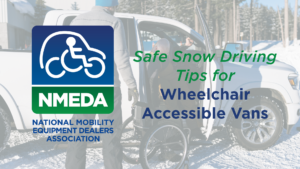Safe Snow Driving Tips for Wheelchair Accessible Vans
Winter weather can be unpredictable and snowstorms present unique challenges for all drivers—especially those relying on wheelchair-accessible vans. This season, record-breaking snowfall has blanketed parts of the southern United States including Florida, Louisiana, and Texas, making preparation and safe driving practices more important than ever.
Here are essential tips to help you navigate snowstorms safely and keep your van and accessibility equipment in peak condition, ensuring both safety and peace of mind on the road:
Pre-Storm Tips for Your Wheelchair-Accessible Van
Proper preparation can make all the difference when driving in hazardous winter conditions. Here are some key tips to ensure your van is ready for winter driving:
- Tire Check: Cold weather can cause tire pressure to drop quickly and snowstorms can make roads extra slick. Before heading out, ensure your tires are properly inflated and have sufficient tread to handle snow and ice.
- Check Antifreeze Levels: Make sure your engine’s antifreeze-to-water ratio is 50/50 to prevent freezing and keep your engine running smoothly.
- Inspect the Battery: Cold weather can reduce battery strength by up to 60%. Have it fully charged and tested to avoid any starting issues.
- Brake Inspection: Ensure brakes, pads, and rotors are in top condition for icy conditions.
- Replace Wiper Blades: Snow, slush, and ice can obstruct visibility. Make sure your wiper blades are in optimal condition to clear your windshield effectively.
- Lubricate Ramp and Doors: Prevent freezing or sticking by lubricating ramp hinges and door sides.
- Stock Emergency Supplies: Include an ice scraper, flashlight, jumper cables, and extra batteries/chargers for your electric wheelchair. Keep mobility aids in good working order and easily accessible.

Winter Driving Tips for Mobility Vehicles
Driving a wheelchair-accessible van during a snowstorm requires extra caution. Follow these essential tips to stay safe and ensure you’re prepared for frigid temperatures and challenging road conditions:
- Monitor the Weather: Always check forecasts and road conditions before heading out.
- Drive Cautiously: Reduce your speed, maintain a safe distance from other vehicles, and avoid sudden movements. Aim to drive 10–15 miles per hour slower than usual on slick or icy roads.
- Stick to Major Roads: Main highways are plowed and salted more frequently, making them safer during snowstorms.
- Watch for Black Ice: Black ice is nearly invisible and forms in shaded areas and on bridges. If you encounter black ice:
-
- Take your foot off both the brake and accelerator.
- Steer straight and allow the vehicle to regain traction.
- Avoid areas where black ice is common, such as shaded spots and bridges.
- Avoid Cruise Control: Always maintain full control of your vehicle to respond quickly to sudden changes in road conditions.
Unique Challenges for Accessible Mobility in Snowstorms
Snowstorms and freezing temperatures bring specific challenges for people with disabilities:
- Navigating Snow and Ice: Uncleared sidewalks and ramps can make it difficult for wheelchair users to move safely through snow and ice.
- Outdoor Accessibility: Extreme cold can limit the amount of time you can spend outside, making it harder to access transportation or essential services.
- Transportation Disruptions: Weather-related delays can impact public transportation and paratransit services, leaving people with disabilities stranded or facing long wait times.
Solutions: Plan ahead by ensuring your assistive devices are winter-ready. Advocate for snow removal on accessible routes and stay in communication with caregivers or transportation providers to ensure your needs are met during winter weather.
Historic Snowstorm Impacting the South
This winter has brought unprecedented snowfall to regions unaccustomed to such weather, with snow reaching as far south as Florida. Areas like Tallahassee and New Orleans are experiencing record snow accumulations. Major highways, including parts of Interstate 10, have been closed, and several states of emergency have been declared across the South.
Governors are urging residents to stay off the roads due to the dangerous conditions, particularly snow-covered bridges and icy stretches. These warnings are especially important for drivers of wheelchair-accessible vans, as road hazards can present additional risks to mobility.
For more information on the Southern Storm, check out these reports:
Stay Safe This Winter
With the current snowstorm affecting large areas, it’s essential to stay prepared when driving a wheelchair-accessible van. If you must hit the road, be sure to follow the winter driving tips mentioned earlier—such as monitoring weather forecasts, driving cautiously, sticking to major roads, and preparing for emergencies. By winterizing your vehicle, following safe driving practices, and staying informed about ongoing weather conditions, you can safely navigate winter roads with confidence.
About NMEDA
The National Mobility Equipment Dealers Association (NMEDA) is an advocate for mobility and accessibility for drivers with disabilities. If you need help with converting or buying a handicap-accessible car, truck, or van, please consider one of our Quality Assurance Program mobility equipment dealers.

